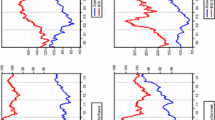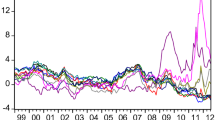Abstract
We use a panel rank cointegration approach to check for the stability conditions of the cross-country money market interest rate basis. Using weekly information on short-term interest rates and spot and forward exchange rates for a set of 20 European economies between 2005 and 2017, we show that in most cases these bases are non-stationary, implying the failure of the covered interest rate parity condition. Concretely, a mean-reverting behavior is encountered in only two cases. The first includes Greece, Italy and Portugal, while the second Belgium, France and Germany.


Similar content being viewed by others
Notes
Violations of the CIP condition have been reported in emerging market economies even before the Subprime financial crisis. See, for instance, Skinner and Mason (2011).
It is important to note that in this study we test for linear cointegration relationships. Given the potential reasons for deviations from the covered interest rate parity condition, there may be nonlinear cointegrating relationships (large versus small deviations) that could be accounted for using threshold autoregressive models (Balke and Fomby 1997), or strongly persistent (fractional) long-run relationships as well [see, for instance, Saikkonen and Choi (2004)].
In our dataset we have both countries whose currency is the Euro and others in which not. For the former, our approach implies stationary interest rate spreads.
Initially, this result could also indicate that some of the time series are I(0). However, we performed additional tests showing that this is not the case. In particular, individual unit root tests for each series were encountered.
Untruncated in this context means that the bandwidth for the long-run variance estimator is taken to be equal to T.
We assume that the long-run variance estimator is calculated using the Bartlett kernel. In this case, the expression for \(\hat{\pmb {\varOmega }}_p\) is simplified as shown by Kiefer and Vogelsang (2002).
From a theoretical point of view, results should be identical regardless of whether bilateral exchange rates (spot and forward) are considered with respect to the US dollar or the Euro. Small differences could be observed if the liquidity of spot and forward exchange rate markets was significantly different, but for exchange rates between non-Euro European countries with respect to the US dollar and the Euro this is not the case. See, for instance, Barkoulas et al. (1997).
Similar results are obtained when the system Johansen cointegration procedure is used instead.
References
Baba N, Packer F (2009) Interpreting deviations from covered interest parity during the financial market turmoil of 2007–08. J Bank Fin 33(11):1953–1962
Balke NS, Fomby TB (1997) Threshold cointegration. Int. Econ Rev 38(3):627–645
Barkoulas J, Baum CF, Oguz GS (1997) Fractional cointegration analysis of long term international interest rates. Int J Fin 9(2):586–606
Baum CF, Barkoulas J (2006) Dynamics of intra-EMS interest rate linkages. J Money Credit Bank 38(2):469–482
Borio C, McCauley R, McGuire P, Sushko V (2016) Covered interest parity lost: understanding the cross-currency basis. Working paper, Bank of International Settlements
Coffey N, Hrung WB, Sarkar A (2009) Capital constraints, counterparty risk, and deviations from covered interest rate parity. Staff report 393, FRB of New York
Du W, Tepper A, Verdelhan A (2018) Deviations from covered interest rate parity. J Fin 73(3):915–957
Engle R, Granger C (1987) Co-integration and error correction: representation, estimation, and testing. Econometrica 55(2):251–276
Gallego S, Garcia Herrero A, Saurina J (2002) The Asian and European banking systems: the case of Spain in the quest for development and stability. Working Papers 0217. Banco de España
Kiefer NM, Vogelsang TJ (2002) Heteroskedasticity-autocorrelation robust standard errors using the Bartlett kernel without truncation. Econometrica 70(5):2093–2095
Pedroni PL, Vogelsang TJ, Wagner M, Westerlund J (2015) Nonparametric rank tests for non-stationary panels. J Econom 185(2):378–391. ISSN 0304-4076
Saikkonen P, Choi I (2004) Cointegrating smooth transition regressions. Econom Theory 20(2):301–340
Skinner FS, Mason A (2011) Covered interest rate parity in emerging markets. Int Rev Fin Anal 20(5):355–363
Wong A, Leung DWY, Ng C (2017) Risk-adjusted covered interest parity: theory and evidence. Working paper, Hong Kong Monetary Authority
Author information
Authors and Affiliations
Corresponding author
Ethics declarations
Conflict of interest
All authors declare they have no conflict of interest.
Ethical approval
This article does not contain any studies with human participants or animals performed by any of the authors.
Additional information
Publisher's Note
Springer Nature remains neutral with regard to jurisdictional claims in published maps and institutional affiliations.
We thank Robert Kunst and two anonymous referees for their insightful comments that were very useful in improving our document. The opinions expressed here are those of the authors and do not represent those of the Banco de la República or its Board of Directors. The usual disclaimers apply.
Appendix A: countries considered
Rights and permissions
About this article
Cite this article
Gomez-Gonzalez, J.E., Gomez-Malagon, S., Melo-Velandia, L.F. et al. A rank approach for studying cross-currency bases and the covered interest rate parity. Empir Econ 59, 357–369 (2020). https://doi.org/10.1007/s00181-019-01633-4
Received:
Accepted:
Published:
Issue Date:
DOI: https://doi.org/10.1007/s00181-019-01633-4
Keywords
- Covered interest rate parity
- Nonparametric rank tests
- Cointegration
- Time series panel
- Cross-currency basis




